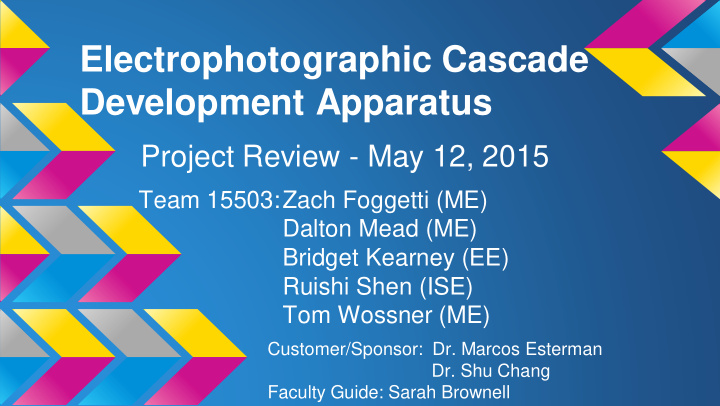



Electrophotographic Cascade Development Apparatus Project Review - May 12, 2015 Team 15503:Zach Foggetti (ME) Dalton Mead (ME) Bridget Kearney (EE) Ruishi Shen (ISE) Tom Wossner (ME) Customer/Sponsor: Dr. Marcos Esterman Dr. Shu Chang Faculty Guide: Sarah Brownell
Agenda ● Background ● Project Overview ● Customer Needs ● Engineering Specs ● Concept Selection & Final Product ● Project Status ● Testing Results ● Major Issues and Findings ● Overall Evaluation & Future work ● Recommendations
Background The focus of this project is the redesign and construction of a xerographic device, called an Electrophotographic Cascade Development Apparatus (ECDA). The ECDA is a piece of test equipment that enables the user to determine whether a specific material is able to be printed onto a surface by means of electrophotography. Such a device is currently being used by RIT faculty and graduate students. However, there is much that can be done to improve the device’s functionality. The new design will allow the user to explore options beyond regular toner particles, such as copper, silver, steel, and other metal or metal alloys.
Project Overview - Old Device Old Device ● Results hard to view o Development zone plates irreplaceable o Required functionality not provided ● Parallelism between plates not guaranteed ● Flow of particles impeded due to transfer surface friction ● Particles hard to be collected after testing
Customer Needs Checklist ● The device must be safe to use ● The device must control the flow of particles ● The device must reduce or eliminate particles lost ● The device must allow easy access to the test sample ● The device must automate as many processes as possible ● The device must handle a range of particle sizes ● The device must be easy to use ● The device must handle the required voltage ● The device must handle large particle samples ● The device must transfer particles using electrophotography ● The device must prevent particle clumping ● The device must allow for a range of spacings between the charged and grounded plates ● The device must handle different types of materials ● The device must allow the charged plates to be easily replaced
Original Engineering Specs
Final Engineering Specs Reasons for Changes: ● Time constraint and lack of manpower o we were not able to accomplish the hopper subsystem ● We were not given the desired types of particles to perform the test ● We were not able to find the benchmark to assess the electrical safety score
Concept Selection ● Transfer surface o Aluminum plate o Ground to achieve smooth surface finish ● Parallel set o Used to simultaneously raise and lower both sides of the upper charged plate o Ensures upper plate is parallel to lower plate ● Angle - rope & cleat o Allows transfer surface angle to be easily adjusted ● Metal clips for development zone o Provides contact points to deliver charge to the upper and lower plates
Final Product - Our Design ● Results easy to view o Development zone plates removable o Required functionality provided ● Parallelism between plates ● Percentage of particles stuck on the transfer surface greatly reduced (~4%) ● Particles can be collected after testing
Final Product - Our Design Video: https://drive.google.com/drive/u/1/folders/0B6O8495bKQ4FY3VvdDhPQ0ViR2s /0B8yBiP- JaMe5NDdSeGFvZkE2dU0/0B6O8495bKQ4FfjJZd0R2T19nbmNRMmFTeWtV ODVKdDBnSjF6LWdFY0pjakR4T3hleDg2RkU/0Bx0fpCwe6CadfmJvOHJta0Vi XzN2N3ZsVjlMWEhTOXEwVWNzd3Y2Rmd1cU1RYWFhSVV0ckE
Project Status ● The final product performs electrophotography well o Subsystems of transfer surface and development zone are a success ● We did not have enough time to finish the hopper subsystem ● We were able to establish a continuous angle system ● Budget o Originally $2500, then cut down to $1500
Key Testing Results ● Only requires 48 seconds (on average) to set up the device before running tests ● Only 4.32% of particles per test (on average) are stuck to transfer surface ● Nearly 0% of particles per test are lost through the system ● Only requires less than 2 seconds (on average) to view the results ● Only requires 13 seconds (on average) to swap out the development zone
Major Issues and Findings ● We lost a team member at the beginning of MSD II o Lack of manpower and time constraint caused incompletion of hopper system ● We failed to purchase all our parts with the right thickness at the beginning o Fortunately this did not cause too much machining trouble; machine shop has the material with right thickness
Overall Evaluation & Future Work ● Completed subsystems meet all the critical customer needs and engineering specs ● Future work o Automate the angle system o Connect the device with computer using LabVIEW so it can be fully controlled and evaluated
Learnings & Recommendations ● What have we learned? o Some ideas were too lofty; should have considered time constraints more carefully o Talk to SMEs earlier and more often o Things often take longer than expected; leave time in the project plan to deal with the unexpected ● Recommendations for MSD program o PRP (ours at least) could have been more thorough/accurate/helpful o End of MSD I evaluation process could have been more thorough (we had some catching up to do in MSD II)
Questions?
Recommend
More recommend